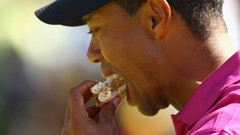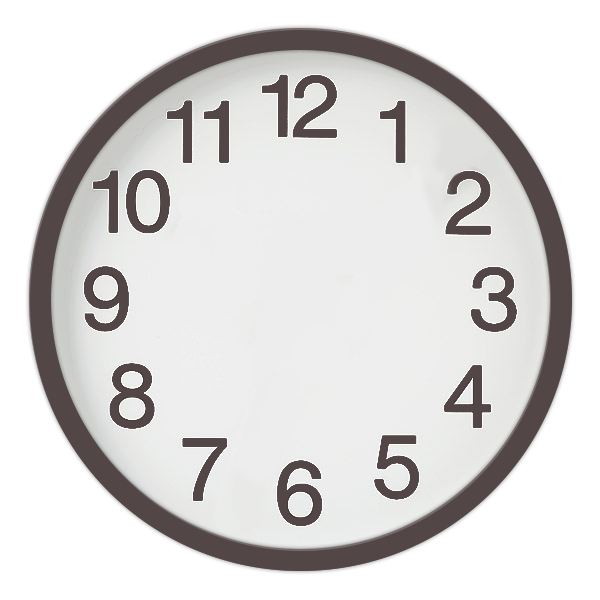SOURCE: www.tigerwoods.com
Diet and Nutrition
Training and competition place a lot of demands on your body. The right diet can improve your performance and help you recover quickly for the next workout. That's especially important for me because I train all year round. I make sure I get enough calories and consume the right kind to fuel my workouts, which can last for hours.
When it comes to eating right, I'm pretty easy to please. I stick to lean meats and seafood, lots of fruits and vegetables and no junk food. My typical breakfast is an egg-white omelet with vegetables. Lunch and dinner is usually grilled chicken or fish with salad and vegetables. Protein ranks high in my diet because it helps build muscle tissue. I also take daily supplements for bone protection and nutritional support.
Every athlete needs some form of complex carbs because they give you a boost for intense training and help fuel your performance for long periods of time. There are lots of theories about how many carbs you need and what types are best. Heavy carb-loading doesn't work for me; instead, I use sports drinks during competition and long workouts. They give me the right mix of carbohydrate energy and electrolytes to keep me going.
For me, a healthy diet isn't just about getting from workout to workout or from competition to competition. It's a lifestyle choice. I'm pretty passionate about building good eating habits for the long-term. I think it needs to start when you're young. That's why I emphasize the importance of fitness and proper nutrition at the Tiger Woods Learning Center for kids. It's the most basic thing we can control when it comes to improving our overall health.
Fitness Philosophy
I view fitness as a long-term strategy for building and maintaining endurance, strength and agility. It's a continuous cycle of training and recovery, which is especially true in golf because there is basically no offseason anymore. Year-round play has increased the emphasis on fitness -- and it's not just about striking the ball harder or farther. It's also about staying in top playing condition so you can avoid injuries and extend your career.
When I first joined the Tour, I was the only one in the gym. Now guys travel with their own trainers. Everyone's getting bigger, stronger and fitter. I don't want to concede anything to the competition, so I train hard all the time. I work out as many as six days a week, even when I'm in a tournament.
It's important not to burn out mentally or physically when you're putting in that much time. I alternate my routines and focus on maintaining my fitness level instead of making big, drastic changes all at once. I go for muscle tone instead of bulk, and I incorporate flexibility training into every session. For golfers, flexibility is critical because we contort our bodies in strange ways. And the older we get, the more our muscles lose elasticity, so we've got to work even harder to keep it.
There is a mental element to my fitness regimen that is just as fundamental as sweat time in the gym or on the golf course. I have a few basic principles I follow, and it helps me stay on track: have patience, be committed and have fun.
When I try to change something, whether it's my swing or my physique, I know it's going to take a lot of patience. Sometimes, you don't see immediate results, and frustration can get you off your game if you let it. A great example of that is my strength-training routine. I've been lifting weights for a long time, but I didn't see real changes until my mid-20s when I was finally able to lay down muscle and keep it. It felt good to see all that work paying off, but it took time because of my body type. Patience kept me focused, and I eventually got the results I wanted.
Just as you have to commit to every swing, you have to commit to your fitness regimen.
I'm always trying to improve, whether it's on the golf course or in the gym. So I ask myself: What do I need to do today to be better than I was yesterday? What am I going to work on tomorrow to be better than I was today? The key to improvement is to commit to your goal and never quit.
When I'm working out, I also want to have fun. Mix up your routine to keep your muscles guessing and to keep yourself from getting bored. If you're working with a trainer or exercising with a friend, challenge each other to make things interesting. Or take a break from the gym altogether and do something that you really enjoy. Besides golf, I like to play tennis, spear-fish and ski. It's nice to get a change of scenery once in awhile and challenge different muscles. And for extra motivation, a good soundtrack can help. Anything from the '80s and early '90s works for me.
The bottom line is fitness is a personal choice. There isn't a one-size-fits-all way of doing it. Find something that works for you and your body type and stick with it. You'll build good fitness habits for life and have some fun while you're at it.
Workout Regimen
I decided a long time ago to treat golf as a sport and full-time profession. When I'm not playing in a tournament, I train from two to 10 hours a day. I'm always trying to improve my conditioning so I can be a better golfer and athlete. Luckily, I like to work out, so training never feels like a chore.
My basic routine includes stretching, core exercises, cardio and weight training. I can spend as much as seven hours on the golf course hitting balls. My trainer, Keith Kleven, designed a great program that keeps my upper and lower body in perfect balance and builds my endurance. Our training sessions are intense and require solid focus. Here's a look at my typical routine.
Cardio training
Cardio is fundamental to my training program. I start off the day with a run or a bike ride. If it's a running day, I either do a three-mile speed run or an endurance run of up to seven miles.
I enjoy the tempo of cardio; it's peaceful and a good way to get focused for the rest of the workout. Of course, cardio also builds endurance and helps deliver oxygen to the muscles, which gets me ready for two-to-three hours of weights.
Weight training
My weight-training program is designed for balance, control and endurance. I lift to enhance my entire body because golf requires upper and lower symmetry. I also develop my right and left sides equally because it improves how I strike the ball.
The idea is to build the strength I need to crush a golf ball rather than develop big muscle volume. I lift sub-maximal weights at higher reps, sometimes 25 to 50, because I'm going for tone and endurance instead of bulk. Bodybuilders usually lift heavier weights in sets of six to 12 because they're going for mass. Sometimes, I add plates to break up the routine and challenge myself, but I rarely lift a lot of weight.
My program works all of my muscle groups, but there are a few areas that need extra focus. Golfers are always hunched over, so it's important to strengthen the back and shoulders to support good posture. Legs are the platform for every swing, so my goal is to create a strong power base.
To keep things interesting, I use a mix of weights, resistance and isometric training. If you keep your muscles guessing, it makes them work harder. Whatever I'm doing, I'm careful not to overstress my muscles. I push to the point of muscle failure, not pain.
Core and flexibility training
Flexibility training is a major component of my regimen. My trainer uses different systems to maintain the flexibility I need to be able to release a powerful swing. I stretch up to 40 minutes before each workout. Then I work on my muscles and joints –- from my spine to my toes -- to create balance and freedom of movement.
For golfers, core strength is just as important as flexibility. Core muscles help control movement and transfer energy from the center of the body out to the limbs, which can obviously impact how well you strike the ball. My core training builds overall strength and flexibility and helps me maintain an ideal state of posture and symmetry.
My workouts are intense and long, but I listen to my body to avoid injury. I know when I can push it and when I need to back off a bit. I don't have time for injuries, so I train hard but smart. A well-rounded program with lots of variety helps me avoid burnout and maintain a high level of conditioning.
Tiger's Daily Routine
Below is Tiger's schedule for a typical practice day at home when he's not playing a tournament.
| 6:30 a.m. |
One hour of cardio. Choice between endurance runs, sprints or biking. |
| 7:30 a.m. |
One hour of lower weight training. 60-70 percent of normal lifting weight, high reps and multiple sets. |
| 8:30 a.m. |
High protein/low-fat breakfast. Typically includes egg-white omelet with vegetables. |
| 9:00 a.m. |
Two hours on the golf course. Hit on the range and work on swing. |
| 11:00 a.m. |
Practice putting for 30 minutes to an hour. |
| Noon |
Play nine holes. |
| 1:30 p.m. |
High protein/low-fat lunch. Typically includes grilled chicken or fish, salad and vegetables. |
| 2:00 p.m. |
Three-to-four hours on the golf course. Work on swing, short game and occasionally play another nine holes. |
| 6:30 p.m. |
30 minutes of upper weight training. High reps. |
| 7:00 p.m. |
Dinner and rest. |
Do you follow a fitness regime of your own? Share your thoughts.









